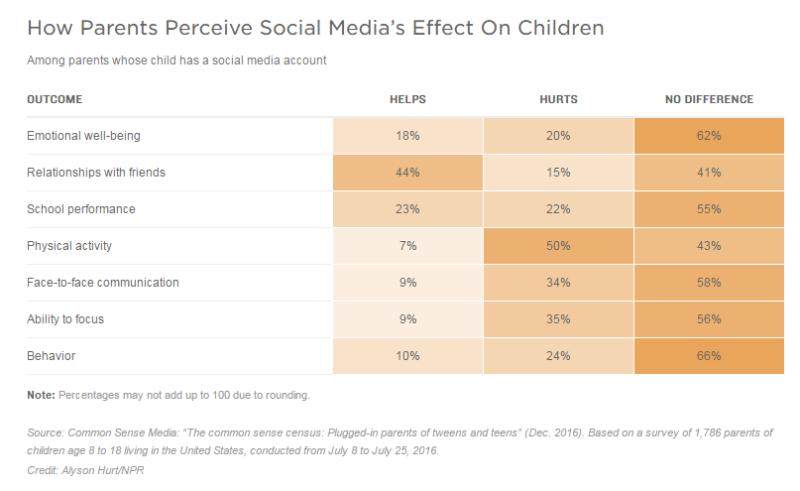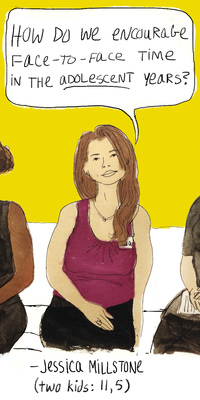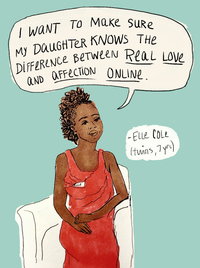
We live in a world of screens. And in this digital age — with so many devices and distraction — it’s one of the things parents worry about most: How much time should their kids spend staring at their phones and computers? What’s the right balance between privacy and self-discovery?
Research continues to provide some answers on how parents are navigating this world. Just today, for example, there’s a new study outthat looks at nearly 2,000 parents — who have kids ages 8 to 18. Among the most surprising findings: People with children spend, on average, 9 hours and 22 minutes per day in front of a screen: texting, tweeting, Googling, checking the weather.
And despite spending a big chunk of their day with a device, most parents — 78 percent — told the researchers that they are modeling good media habits for their kids.
The report’s biggest takeaway? Screen time isn’t going anywhere. So let’s talk about it.

“Media and technology are essential to family life and to childhood and adolescence, and therefore we have to get more on top of it, ” says Jim Steyer. He’s the president and CEO of Common Sense Media, an organization that focuses on kids, media and technology, and the group behind the new research.
In this blog’s 2 1/2 years running, some of our most popular posts have touched on parenting questions.
Recently, we gathered a group of about 20 parents to talk about some of these questions. With help from Generation Listen, the group at NPR that connects with listeners in person to talk about stories and ideas, we settled in on the couches at the Manhattan headquarters of the nonprofit think tank Data & Society.
We started the night with some observations from NPR Ed: We don’t think there’s ever been a generation of parents that’s been so thoughtful about what they’re doing, but also sometimes nervous and whipsawed by confusion and by different sources.
Some parents offered advice and experience, others just came with questions. And the conversation quickly zeroed in on issues related to screens: both kids with their screens, and parents’ own use of online and digital media.
Here are some of the highlights:
What to do at home about screen time
Jessica Millstone has an 11-year-old and a 5-year-old and works for an ed-tech company called
Brainpop:
“One thing that we kind of started talking a little bit about is that, when you are using your screens, what are you not doing? … You just don’t spend as much time talking to another person. How do we really encourage face-to-face stuff in the adolescent and older teen years as this technology really permeates every aspect of life?”
(New recommendations from the American Academy of Pediatrics suggest creating a “family media plan” that emphasizes balancing tech with other activities.)
Jim Steyer, from Common Sense Media, suggests setting aside certain times where everyone can put down the devices: like at the dinner table, or in bed.
“As a parent, you are your child’s most important role model,” says Steyer. “How you use media, how you use technology and how much you use it, is critically important.”
Amanda Lenhart has four daughters ages 4 to 21, and researches kids and technology. She gave an example of when her daughter had to turn in her phone before a camping trip, and how much she wound up enjoying the time unplugged. “I think some teens and young adults and kids may be longing for time away from the technology as much they long for time on it.”
(Here’s a research study that suggests even a short break from technology can improve teenagers’ ability to read others’ emotions.)
Many parents shared that they are seeing their kids being very creative with technology, and they want to encourage that, but they still have mixed feelings.


“One thing that we kind of started talking a little bit about is that, when you are using your screens, what are you not doing? … You just don’t spend as much time talking to another person. How do we really encourage face-to-face stuff in the adolescent and older teen years as this technology really permeates every aspect of life?”
(New recommendations from the American Academy of Pediatrics suggest creating a “family media plan” that emphasizes balancing tech with other activities.)
Jim Steyer, from Common Sense Media, suggests setting aside certain times where everyone can put down the devices: like at the dinner table, or in bed.
“As a parent, you are your child’s most important role model,” says Steyer. “How you use media, how you use technology and how much you use it, is critically important.”
Amanda Lenhart has four daughters ages 4 to 21, and researches kids and technology. She gave an example of when her daughter had to turn in her phone before a camping trip, and how much she wound up enjoying the time unplugged. “I think some teens and young adults and kids may be longing for time away from the technology as much they long for time on it.”
(Here’s a research study that suggests even a short break from technology can improve teenagers’ ability to read others’ emotions.)
Many parents shared that they are seeing their kids being very creative with technology, and they want to encourage that, but they still have mixed feelings.

Elle Cole, a blogger and the mother of 7-year-old twins, said that recently, one of her daughters came to her and told her she wanted to start her own YouTube channel, making videos about building with Legos. “But I’m very protective of her because I also know the dangers. … When she said that, I was like, ‘Oh, no,’ because to me, that’s a world that’s not always real.”
What about privacy and safety online?
Amanda Lenhart (speaking from both her personal experience and her research): “I think that a lot of adolescents are really quite thoughtful about the kinds of information and things that they’re sharing online. They’re thinking a lot about it, they’re curating what they place up in digital space. And a lot of that is partly because they want their peers to see a particular version of themselves, but also that we as parents and teachers and administrators and adults tell them that we’re watching.”
(Student privacy concerns continue to grow. Software installed on school-owned computers is often designed to track kids even when they’re at home, which leads to privacy concerns, our reporting found.)
Adanna Dill is a blogger and shares a lot of information about her young children, ages 6 and 3, online.

What about privacy and safety online?
Amanda Lenhart (speaking from both her personal experience and her research): “I think that a lot of adolescents are really quite thoughtful about the kinds of information and things that they’re sharing online. They’re thinking a lot about it, they’re curating what they place up in digital space. And a lot of that is partly because they want their peers to see a particular version of themselves, but also that we as parents and teachers and administrators and adults tell them that we’re watching.”
(Student privacy concerns continue to grow. Software installed on school-owned computers is often designed to track kids even when they’re at home, which leads to privacy concerns, our reporting found.)
Adanna Dill is a blogger and shares a lot of information about her young children, ages 6 and 3, online.

“I felt like there was a need for diversity in the mom-blogging sphere. So I wanted to share content with people who looked like me and understood what I was going through, but I felt like I had to share a little bit more about myself and my family for them to connect with me. So I started, slowly but surely, sharing my kids, sharing a bit more about my family. And it’s good, because now parents email me and they say, ‘Oh, my daughter has hair like yours, and I’m learning how to do her hair because of you sharing different things.’ But at the same time, sometimes I don’t feel very comfortable, because I don’t know who these people are. … I want to grow my community, but at the same time I want to protect my family, and I just really don’t know who’s out there, so there are periods where I stop posting about my kids for a while.”
What are schools doing with all this digital media? Are schools helping get kids engaged in digital creating?
Jessica Millstone told us that, based on her work in schools, “I’ve seen a huge shift in teachers. Younger teachers have a more fluent use of technology, but it still really lags from where the kids are.

“I do see that in a lot of the schools that I visit and I work in, where it’s really difficult to get something innovative or experimental or just plain fun into the classroom, and teachers need that. They seek that. They need ways to engage kids that are digital natives and who really expect a kind of digital experience.
“There is this atmosphere of kind of lockdown against electronics that comes into play, where there’s just a real bias against it from the beginning. I think it’s going to have to come from parent demand in some way — like, I need this to be part of what they do, so appropriate use is scaffolded and modeled, so they can build and use all of these tools for their learning, as well as their entertainment and fun.
“At the same time, I think that the motivation for a lot of schools to keep technology out is to provide a space in a world of ubiquitous technology, where for a few hours you are only speaking to people face-to-face and you are interacting in a more non-technologically based, mediated way. And I fully respect that too. I do wish more schools had sort of an intentional balance [around digital media].”
https://ww2.kqed.org/mindshift/2016/12/06/how-do-parents-honor-the-benefits-of-digital-devices-while-limiting-kids-use/
What are schools doing with all this digital media? Are schools helping get kids engaged in digital creating?
Jessica Millstone told us that, based on her work in schools, “I’ve seen a huge shift in teachers. Younger teachers have a more fluent use of technology, but it still really lags from where the kids are.

“I do see that in a lot of the schools that I visit and I work in, where it’s really difficult to get something innovative or experimental or just plain fun into the classroom, and teachers need that. They seek that. They need ways to engage kids that are digital natives and who really expect a kind of digital experience.
“There is this atmosphere of kind of lockdown against electronics that comes into play, where there’s just a real bias against it from the beginning. I think it’s going to have to come from parent demand in some way — like, I need this to be part of what they do, so appropriate use is scaffolded and modeled, so they can build and use all of these tools for their learning, as well as their entertainment and fun.
“At the same time, I think that the motivation for a lot of schools to keep technology out is to provide a space in a world of ubiquitous technology, where for a few hours you are only speaking to people face-to-face and you are interacting in a more non-technologically based, mediated way. And I fully respect that too. I do wish more schools had sort of an intentional balance [around digital media].”
https://ww2.kqed.org/mindshift/2016/12/06/how-do-parents-honor-the-benefits-of-digital-devices-while-limiting-kids-use/


